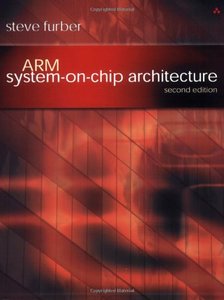Embedded Systems: ARM Programming and Optimization (Paperback)
暫譯: 嵌入式系統:ARM 程式設計與優化 (平裝本)
Jason D. Bakos
- 出版商: Morgan Kaufmann
- 出版日期: 2015-09-25
- 售價: $1,200
- 貴賓價: 9.8 折 $1,176
- 語言: 英文
- 頁數: 320
- 裝訂: Paperback
- ISBN: 0128003421
- ISBN-13: 9780128003428
-
相關分類:
ARM
-
相關翻譯:
ARM 嵌入式系統編程與優化 (Embedded Systems:ARM Programming and Optimization) (簡中版)
-
其他版本:
Embedded Systems: ARM Programming and Optimization 2nd Edition
買這商品的人也買了...
-
 ARM System-on-Chip Architecture, 2/e ( 美國原版)
ARM System-on-Chip Architecture, 2/e ( 美國原版)$2,720$2,584 -
 人月神話:軟體專案管理之道 (20 週年紀念版)(The Mythical Man-Month: Essays on Software Engineering, Anniversary Edition, 2/e)
人月神話:軟體專案管理之道 (20 週年紀念版)(The Mythical Man-Month: Essays on Software Engineering, Anniversary Edition, 2/e)$480$379 -
 大話設計模式
大話設計模式$620$490 -
 Linux Device Driver Programming 驅動程式設計
Linux Device Driver Programming 驅動程式設計$690$538 -
 ARM Linux 核心嵌入式系統開發指南
ARM Linux 核心嵌入式系統開發指南$900$855 -
 程式設計師的自我修養-連結、載入、程式庫
程式設計師的自我修養-連結、載入、程式庫$580$493 -
 王者歸來-PHP 完全開發範例集, 2/e
王者歸來-PHP 完全開發範例集, 2/e$860$731 -
 無瑕的程式碼-敏捷軟體開發技巧守則 + 番外篇-專業程式設計師的生存之道 (雙書合購)
無瑕的程式碼-敏捷軟體開發技巧守則 + 番外篇-專業程式設計師的生存之道 (雙書合購)$940$700 -
 Professional Embedded ARM Development (Paperback)
Professional Embedded ARM Development (Paperback)$1,560$1,482 -
 網路行銷:3A 時代來臨, 4/e
網路行銷:3A 時代來臨, 4/e$540$378 -
 ASP.NET MVC 5 網站開發美學
ASP.NET MVC 5 網站開發美學$780$616 -
 Linux Kernel 設計的藝術:圖解 Linux 操作系統架構設計與實現原理 (徹底研究 Linux Kernel 設計的藝術-圖解 Linux 作業系統設計架構與運作原理)
Linux Kernel 設計的藝術:圖解 Linux 操作系統架構設計與實現原理 (徹底研究 Linux Kernel 設計的藝術-圖解 Linux 作業系統設計架構與運作原理)$780$663 -
 Xilinx All Programmable Zynq-7000 SoC 設計指標 (王者歸來-Xilinx All Programmable Zynq 7000 SoC 設計指南)
Xilinx All Programmable Zynq-7000 SoC 設計指標 (王者歸來-Xilinx All Programmable Zynq 7000 SoC 設計指南)$860$731 -
 大話重構
大話重構$390$304 -
 精通 Python|運用簡單的套件進行現代運算 (Introducing Python: Modern Computing in Simple Packages)
精通 Python|運用簡單的套件進行現代運算 (Introducing Python: Modern Computing in Simple Packages)$780$616 -
 嵌入式系統設計入門─ARM Cortex A9 (ARM Cortex A9 嵌入式系統設計寶典 Base on Xilinx Zynq)
嵌入式系統設計入門─ARM Cortex A9 (ARM Cortex A9 嵌入式系統設計寶典 Base on Xilinx Zynq)$580$493 -
 iOS 9 App 程式設計實力超進化實戰攻略:知名iOS教學部落格AppCoda作家親授實作關鍵技巧讓你不NG (Beginning iOS 9 Programming with Swift)
iOS 9 App 程式設計實力超進化實戰攻略:知名iOS教學部落格AppCoda作家親授實作關鍵技巧讓你不NG (Beginning iOS 9 Programming with Swift)$690$538 -
 Raspberry Pi 最佳入門與實戰應用, 2/e (適用 Raspberry Pi 2/Raspberry Pi 第一代)
Raspberry Pi 最佳入門與實戰應用, 2/e (適用 Raspberry Pi 2/Raspberry Pi 第一代)$450$356 -
 CSS Secrets 中文版|解決網頁設計問題的有效秘訣 (CSS Secrets: Better Solutions to Everyday Web Design Problems)
CSS Secrets 中文版|解決網頁設計問題的有效秘訣 (CSS Secrets: Better Solutions to Everyday Web Design Problems)$680$537 -
ARM 系統開發者指南 (ARM System Developer's Guide: Designing and Optimizing System Software)
$800$720 -
 設計模式與遊戲開發的完美結合
設計模式與遊戲開發的完美結合$690$538 -
 科學運算 : Python程式理論與應用
科學運算 : Python程式理論與應用$860$731 -
 ASP.NET 專題實務 II--範例應用與進階功能
ASP.NET 專題實務 II--範例應用與進階功能$820$648 -
 $354操作系統之編程觀察
$354操作系統之編程觀察 -
 奔跑吧!Linux kernel|Linux 4.x kernel 關鍵與原始程式碼解析
奔跑吧!Linux kernel|Linux 4.x kernel 關鍵與原始程式碼解析$880$695
商品描述
Embedded Systems: ARM Programming and Optimization combines an exploration of the ARM architecture with an examination of the facilities offered by the Linux operating system to explain how various features of program design can influence processor performance. It demonstrates methods by which a programmer can optimize program code in a way that does not impact its behavior but improves its performance. Several applications, including image transformations, fractal generation, image convolution, and computer vision tasks, are used to describe and demonstrate these methods. From this, the reader will gain insight into computer architecture and application design, as well as gain practical knowledge in the area of embedded software design for modern embedded systems.
- Covers three ARM instruction set architectures, the ARMv6 and ARMv7-A, as well as three ARM cores, the ARM11 on the Raspberry Pi, Cortex-A9 on the Xilinx Zynq 7020, and Cortex-A15 on the NVIDIA Tegra K1
- Describes how to fully leverage the facilities offered by the Linux operating system, including the Linux GCC compiler toolchain and debug tools, performance monitoring support, OpenMP multicore runtime environment, video frame buffer, and video capture capabilities
- Designed to accompany and work with most of the low cost Linux/ARM embedded development boards currently available
商品描述(中文翻譯)
《嵌入式系統:ARM 程式設計與優化》結合了對 ARM 架構的探索與對 Linux 作業系統所提供功能的檢視,以解釋程式設計的各種特性如何影響處理器性能。它展示了程式設計師可以優化程式碼的方法,這些方法不會影響程式的行為,但能改善其性能。書中使用了幾個應用案例,包括影像轉換、分形生成、影像卷積和計算機視覺任務,來描述和演示這些方法。讀者將從中獲得對計算機架構和應用設計的深入了解,並在現代嵌入式系統的嵌入式軟體設計領域獲得實用知識。
- 涵蓋三種 ARM 指令集架構,ARMv6 和 ARMv7-A,以及三種 ARM 核心,分別是 Raspberry Pi 上的 ARM11、Xilinx Zynq 7020 上的 Cortex-A9 和 NVIDIA Tegra K1 上的 Cortex-A15
- 描述如何充分利用 Linux 作業系統所提供的功能,包括 Linux GCC 編譯器工具鏈和除錯工具、性能監控支援、OpenMP 多核心執行環境、視頻幀緩衝區和視頻捕捉能力
- 設計用於配合和使用目前大多數低成本的 Linux/ARM 嵌入式開發板











